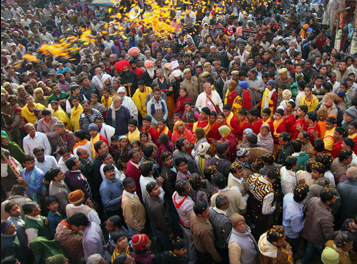
10 Dead in Maha Kumbh Stampede
A devastating stampede occurred on Mauni Amavasya, one of the most significant days of the Maha Kumbh Mela in India, leading to the loss of at least 10 lives and injuring over 40 people. This tragic incident unfolded during the ‘Amrit Snan’ (Holy Bath) event at the Kumbh Mela, which is held once every 12 years in Allahabad (Prayagraj), Uttar Pradesh. Mauni Amavasya is considered one of the most auspicious days for pilgrims, with millions of devotees converging to take a ritual dip in the holy waters of the Sangam, the confluence of the Ganges, Yamuna, and the mythical Saraswati rivers.
What Happened at the Maha Kumbh Mela?
The Maha Kumbh Mela is one of the largest religious gatherings in the world, attracting millions of Hindu pilgrims seeking spiritual purification. The stampede occurred at the Sangam area, where the largest concentration of devotees gathers on significant bathing days. On Mauni Amavasya, devotees observe fasting, prayer, and deep spiritual reflection, and the holy dip on this day is believed to cleanse them of their sins.
The stampede, which took place in the early hours of the day, was triggered by a sudden surge of devotees attempting to reach the riverbanks. While the exact cause of the incident is still under investigation, eyewitness reports suggest that the overwhelming crowd and lack of proper crowd control measures played a significant role. The narrow paths leading to the river became congested, and a sudden rush caused people to fall and get trampled underfoot.
The authorities had anticipated a high turnout on Mauni Amavasya and had deployed additional police and security personnel to ensure safety, but the scale of the crowd proved difficult to manage. The event was marred by inadequate crowd management, and the stampede left many injured, some severely.
Immediate Response and Rescue Efforts Maha Kumbh Stampede
As the tragic events unfolded, emergency response teams, including paramedics and police, rushed to the scene. Several injured pilgrims were immediately transported to nearby medical facilities for treatment. The incident also prompted a massive response from the local administration, with ambulances and rescue teams working tirelessly to save lives. Helicopters were also deployed to transport the critically injured to better-equipped hospitals in the region.
While many victims were treated for fractures and bruises, some of the injuries were more severe, including head injuries, broken limbs, and trauma from being crushed in the stampede. The local hospitals were put on high alert, with medical staff working round the clock to handle the influx of injured persons.
The Aftermath: Loss of Life and Continued Chaos
In the aftermath of the stampede, authorities confirmed that at least 10 people had lost their lives, with over 40 others injured, many of them in critical condition. The authorities quickly began to clear the affected areas, allowing for better access for emergency responders and preventing further casualties.
As the news of the stampede spread, people gathered in large numbers near the medical camps and along the riverbanks, trying to help the injured or search for missing family members. Many pilgrims, already shaken by the incident, expressed their grief and distress, as the Kumbh Mela, a symbol of spiritual reverence, had turned into a scene of tragedy.
The Role of Crowd Management and Safety Protocols Maha Kumbh Stampede
One of the main reasons for the stampede was the lack of effective crowd control measures. Despite the scale of the event and the heavy turnout anticipated on Mauni Amavasya, the authorities appeared to be ill-prepared to manage such a massive congregation of people. Several reports indicated that the narrow passageways and inadequate barriers led to chaos when large numbers of devotees tried to converge on the river.
Crowd management is always a challenge during such large-scale religious events, and this tragedy highlights the critical importance of having robust safety protocols in place. Proper barriers, adequate personnel to direct the flow of pilgrims, and contingency plans for such situations are essential to prevent stampedes. With millions attending the Kumbh Mela, authorities must implement better planning to ensure the safety of the devotees, especially during peak bathing days like Mauni Amavasya.
Maha Kumbh Stampede: Government Response and Condolences
Following the incident, the Chief Minister of Uttar Pradesh, along with other local officials, expressed their deepest condolences to the families of the victims and assured that the injured would receive the best medical care. The state government has ordered an investigation into the causes of the stampede and pledged to take steps to prevent such incidents in the future.
Prime Minister Narendra Modi also expressed his grief over the tragic loss of life and offered condolences to the families of the victims. The Ministry of Home Affairs has been coordinating with state officials to provide all necessary assistance to the victims’ families and to ensure that the situation remains under control in the aftermath.
Lessons and Reforms for Future Kumbh Melas Maha Kumbh Stampede
The tragic stampede has once again highlighted the importance of effective planning and management at large-scale religious gatherings. For the Kumbh Mela to continue to be a safe and sacred event, authorities need to invest more in infrastructure, crowd control, and emergency preparedness. Pilgrims flocking to such events should be able to do so without the risk of losing their lives due to poor planning.
In future editions of the Kumbh Mela, there should be a focus on:
- Improved crowd management: Ensuring that pathways are wide enough and clearly marked to avoid congestion.
- Adequate infrastructure: Ensuring there are enough entry and exit points to handle the volume of people efficiently.
- Advanced medical facilities: Having more medical personnel on standby and ensuring faster access to healthcare for injured individuals.
- Technology integration: Using drones and real-time data to monitor crowds and detect potential risks ahead of time.
Conclusion: A Tragic Day at the Kumbh Mela
The stampede on Mauni Amavasya at the Maha Kumbh Mela is a devastating reminder of the challenges posed by massive religious gatherings. While millions gather to seek spiritual fulfillment, tragedies like this underscore the need for authorities to prioritize the safety and well-being of the pilgrims. The loss of life and the many injuries from this incident have shaken the entire nation, and the focus now must be on providing support for the affected families while ensuring that lessons are learned to prevent such incidents in the future. Maha Kumbh Stampede
The Maha Kumbh Mela, while a deeply spiritual event, must also evolve to prioritize safety, ensuring that no life is lost due to preventable circumstances. As investigations continue and aid reaches the victims, the focus should shift to a comprehensive review of crowd management protocols and ensuring that safety measures are in place for the future.





